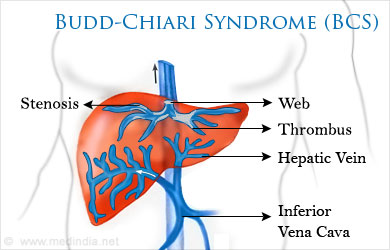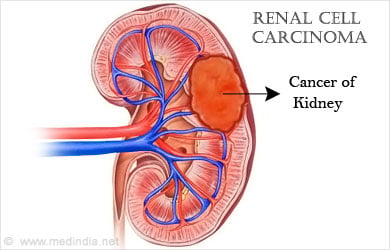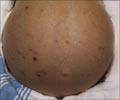- Budd-Chiari Syndrome - (http://www.patient.co.uk/doctor/budd-chiari-syndrome.htm)
- Hepatic vein obstruction (Budd-Chiari) - (http://www.nlm.nih.gov/medlineplus/ency/article/000239.htm)
- Ulrich F, Pratschke J, Neumann U, et al. Eighteen years of liver transplantation experience in patients with advanced Budd-Chiari syndrome. Liver Transpl. 2008 Feb;14(2):144-50.
- Shih KL, Yen HH, Su WW, et al. Fulminant Budd-Chiari syndrome caused by renal cell carcinoma with hepatic vein.Eur J GastroenterolHepatol. 2009 Feb;21(2):222-4.
What is Budd-Chiari Syndrome (BCS)?
Budd-Chiari Syndrome (BCS) is a rare disorder caused by narrowing and obstruction (occlusion) of the hepatic veins (veins in the liver).
Budd-Chiari Syndrome (BCS) is a rare disorder caused by narrowing and obstruction of the hepatic veins. The hepatic veins are veins that carry blood from the liver to the inferior vena cava, from where the blood subsequently moves into the right side of the heart. Thus, narrowing of the veins prevents the free-flow of blood from the liver to the heart.
Obstruction of the veins is usually caused by blood clots in the vessel (hepatic vein thrombosis). It may also be due to the formation of a fibrous web in the blood vessel. The condition affects males and females in equal numbers.

Causes of Budd-Chiari Syndrome (BCS)
BCS is most often caused by conditions that increase the tendency of a person to develop blood clots. In some cases, fibrous tissue growth in veins causes the condition. Some patients are genetically prone to develop BCS. In many cases, the cause cannot be localized.
Causes of BCS include:
- Blood disorders
- Polycythemia vera (a blood cancer in which the bone marrow makes too many red blood cells. It also leads to increased white-blood cell and platelet counts)
- Thrombophilic conditions due to abnormalities in blood clotting factors (e.g. protein C/S deficiency, deficiency in antithrombin III or factor V Leiden)
- Essential thrombocytosis (high platelet counts)
- Antiphospholipid antibody syndrome (an autoimmune disorder where antibodies attack the body’s own cells and tissues)
- Paroxysmal nocturnal hemoglobinuria (PNH is a rare, genetically acquired, life-threatening disease of the blood caused by destruction of red blood cells)
- Post-bone marrow transplant complications
- Other bone marrow disorders
- Chronic infections
- Hydatid cysts (a parasitic disease of tapeworms)
- Aspergillosis (fungi infecting tissues especially of the lungs)
- Amebic abscess
- Syphilis
- Tuberculosis
- Chronic inflammatory diseases
- Behçet disease (rare disorder causing inflammation of blood vessels throughout the body)
- Sarcoidosis (a disease of unknown origin causing enlargement of lymph nodes)
- Systemic lupus erythematosus (SLE is an autoimmune disease that can affect the skin, joints, kidneys, brain and other organs)
- Sjögren syndrome (an autoimmune disease in which the patient’s white blood cells attack the salivary and tear glands causing chronic dry eyes and mouth)
- Obstetrics
- Pregnancy
- Post-partum
- Drugs
- Oral contraceptives
- Hormone replacement therapy (HRT)
- Cancers
- Hepatocellular carcinoma
- Renal cell carcinoma

- Wilm’s tumor (a malignant kidney tumor usually occurring in children)
- Adrenal carcinoma
- Leiomyosarcoma (rare cancer of the connective tissues including bone, cartilage, fat, muscle and blood vessels)
- Other causes
- Alpha1-antitrypsin (A1AT) deficiency (a genetic disorder causing defective production of alpha 1-antitrypsin thereby depositing excess abnormal A1AT protein in the liver cells)
- Idiopathic (cause is unknown)
Symptoms of Budd-Chiari Syndrome (BCS)
Symptoms of BCS appear only after the involvement of more than one hepatic veins. Common symptoms and signs include pain in the upper right side of the abdomen over the liver, liver enlargement, fluid accumulation in the abdomen, fatigue, nausea and jaundice.
Some cases of BCS present with high blood pressure due to portal hypertension. This occurs when there is increased pressure in the veins carrying blood from the digestive tract to the heart via the liver. Many patients present with altered and elevated liver functions. Patients also present with an enlarged spleen (splenomegaly), ankle edema (swelling at the ankles) and prominence of collateral veins.
Clinical Variants of Budd-Chiari Syndrome (BCS)
Clinical variants of BCS include:
- Acute and sub-acute form, where the patient presents with sudden and rapid development of severe abdominal pain, ascites, liver enlargement, jaundice and renal failure.
- Chronic form, which is the most common presentation. Patients present with ascites and renal impairment.
- Fulminant form, which is an uncommon presentation. Patients present with ascites (fluid accumulation in the abdomen), painful liver enlargement, jaundice and renal failure.
Diagnosis and Treatment for Budd-Chiari Syndrome (BCS)
Diagnosis for BCS involves a combination of clinical evaluation, laboratory studies, imaging and liver biopsy. Treatment depends on the severity and progression of the condition.
Diagnosis of BCS is made based on:
- Clinical evaluation: This includes a detailed abdominal examination.
- Laboratory studies: include liver function tests and examination of ascitic fluid (if ascites is present). Some of the useful lab indicators are:
- High protein concentrations (>2g/dL)
- Low white-blood cell count (<500/ µL)
- Serum ascites–albumin gradient is usually less than 1.1
- Imaging: include Doppler ultrasonography, computed tomography (CT scan), magnetic resonance imaging (MRI scan) and venography.

- Biopsy: is usually recommended to rule out cirrhosis of the liver.
Treatment for Budd-Chiari Syndrome (BCS)
Treatment for BCS includes the following:
- Anticoagulant therapy - If the blockage is caused by a clot, anticoagulant drugs such as warfarin can help in preventing the clots from recurring. The patient should be monitored regularly to maintain the anticoagulant effect within the acceptable range.
- Percutaneous transluminal angioplasty - can help widen the veins narrowed by clots. This procedure involves placing a stent to keep the vein open.
- Transjugular intrahepatic portal-systemic shunting (TIPS) - can create an alternate route for blood flow thereby bypassing the liver. This reduces the pressure on the hepatic portal vein. This procedure is necessary if the patient presents with portal hypertension.
- Liver transplant - is another life-saving option especially for people with severe liver decompensation and failure.
Management of symptoms:
- Ascites should be managed with diuretics along with fluid and salt restrictions. A general low-sodium diet is recommended for all patients.
- Esophageal and gastric varices need to be ruled out with a gastroscopy and if present need to be treated with banding or sclerotherapy (an injection with a special chemical (sclerosant) is injected into the vein to damage and scar the lining of the vein thereby closing it).

Complications and Prognosis of Budd-Chiari Syndrome (BCS)
BCS can lead to a range of complications which needs to be treated symptomatically.
Some of the complications include:
- Portal hypertension
- Esophageal varices and bleeding
- Bacterial peritonitis
- Hepatorenal syndrome (in advanced cases of cirrhosis)
- Hepatic encephalopathy or total hepatic failure
Prognosis
Identifying, correlating symptoms and making an accurate diagnosis has a major impact on prognosis. Medical and surgical interventions have been successful in keeping patients alive up to eight years after which liver transplant may be required. The ten-year survival rate is 55% as reported.
Patients with portal hypertension and portal vein thrombosis have a poor prognosis.
In advanced cases, liver transplant is recommended before renal failure sets in.








